
Rob Greenwood justifies his recent trip to Font with a thorough look at SNAP's latest pad, the curiously named 'Guts'.
The original SNAP Wrap was something of a revolution in bouldering mat design, insofar as it moved away from the traditional construction used throughout the industry at the time, which involves - as it still does today - sandwiching a single soft layer between two high density layers of foam. Instead, it featured their unique 'air cell' technology, which through a series of sewn cubes, each filled with foam, releases air at a variable rate depending on the size of the fall you're taking. For 2019 the range has been changed, with the Wrap being essentially re-named the Wham, and the (curiously named) Guts, which we're reviewing here, being introduced as a hinged counterpart.
Given that it's been three years since we put the original through its paces it's probably worth recapping, and elaborating, on the air cell technology within, as that is - fundamentally - one of the major draws of the Guts (I still can't believe they called it that…). Within the Guts' innards are the following forms of shock absorption:
12cm high density impact absorbing polyurethane foam - this is the 'air cell' component, which is found inside the sewn cubes that are velcroed together inside the pad. If you fall gently, or sit on them, then the air is released slowly, hence it can - upon first acquaintance, feel like quite a soft pad; however, when falling from height this immediately changes, as less air can escape due to the increased speed of travel - hence it feels much firmer (not too firm, I hasten to add).
20mm high density impact reducing EVA foam - this layer sits over the top of the other layer (i.e. the cubes) and helps to spread the load more evenly across the whole pad. The fact this sits on the top means that there is indeed a correct and incorrect way to use the pad, as flipping it the wrong way up would result in a much MUCH softer landing (that isn't really recommended).
The pros of the above are that the Guts (and the Wham alike) give a uniquely adapted landing depending on exactly how you fall. This is particularly desirable whilst highballing, as the other thing that the pad takes out (aside from the force) is the bounce that you get with conventional three layer foam pads. If you land on the Guts, then the chances are that's where you're going to stay. This can't be said with many other pads, where you'll often bounce and roll - especially when falling from height.
If there's a pad you're looking to take highballing there may be a plethora of large pads out there to choose from, but nothing with performance quite like this.
Were there to be a drawback it is that this technology isn't the most minimalist, in fact it's pretty bulky, and it is so on two grounds with the Guts. Firstly, the air cells require a lot of depth, hence it's quite chunky from the word go, but this is amplified further because of its dimensions - 150x100x15cm is pretty sizeable even in the present day where pads seem to be getting larger. In fact, one thing I would highly recommend - if you're interested in the Guts or the Wham - is to make sure it fits in your car before considering a purchase. I own a Berlingo, a car I'd always considered to be one of the best on the market for swallowing up large bouldering mats, but the Guts is too wide to lay flat in the boot.
The second drawback is that it is - perhaps unsurprisingly - not an overly light pad, coming in at 8.5kg, which isn't ideal on long walk-ins or when carting it around a circuit. That said, I found myself reaching for this pad time and time again because of the fact it could be relied upon, irrespective of the height of the problem.
Taco vs. Hinge
Now it's worth highlighting that the Guts and the Wham have virtually identical features, so here's a brief overview of my take on the benefits of taco vs. hinge - that way I can leave you to decide which best suits your needs
Taco
Pros: consistent performance across the entire pad, with no hinge/deadspot to fall into, and great for packing packing stuff inside
Cons: they're bloody huge and should really be stored unfolded
Hinge
Pros: far easier to transport and store, and generally less of a faff
Cons: Dead spot in the middle can present a problem; plus there's no additional space to pack things inside
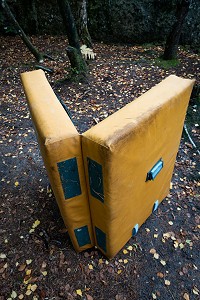
Fabric/Materials
In all our reviews here on UKCa products' environmental credentials are being called into question more and more - and rightly so. With the Guts, and throughout the rest of the SNAP range, the outer is constructed using 100% recycled polyester, which is given a further boost given the PVC free TPU coating. From a UK perspective, where we tend to be operating in a warm/wet environment with lots of mud, this really is a winning combination, and is part of the pad's appeal. The pad itself is bordering on 'wipe clean', and doesn't soak up the moisture like an uncoated fabric would; furthermore, it adds to the overall durability of the pad, with a very tough feel that is yet to show any signs of weakness.
Features
The Guts features a removable waist belt and shoulder straps, for when the going gets particularly muddy, and you'd rather keep the straps clean (even if the rest of the pad is filthy, at least it can be wiped down quite easily courtesy of the finish). Once the shoulder strap's velcro is undone there's a small sleeve along the base of the pad, inside which they can be tucked so that they're out the way and not going to be landed on. There's also a small mat on which to wipe your feet, which is always useful if you want to keep your climbing shoes clean.
The closure to the pad (and for the shoulder straps) is virtually all velcro, which I must admit to having mixed feelings about. During six months of use they are, unsurprisingly, fine, but my concern would be that this is where the one weakness might be within a pad that would otherwise last a long, long time. Velcro has a habit of perishing, especially when it gets filled with grass, dirt, and mud. Another minor gripe was that the metal loops the straps run through are quite tightly machined, hence they're initially quite awkward to fit through; however, I think this is equally a problem with just how stiff the straps are to begin with, and after a bit of use they loosened up and became much easier to fit through and use.
Price
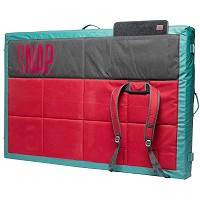
It's also worth mentioning that the Guts' taco counterpart, the Wham, is available at the same price.
Summary
The Guts is a big, burly, and dependable pad. It's not necessarily the lightest, but weight isn't its primary focus - it's the comfort and variation of the 'catch' it gives you whilst falling. When it comes to highballing, the Guts really comes into its own, with few pads being able to rival its performance. When it comes to construction it's built to last, with a coating that is ideal for the UK due to its water resistant and wipe clean nature. Weight-wise it is - perhaps unsurprisingly - pretty heavy, but what do you expect from a large bouldering mat?! So whilst the price may be high, considering all the features I'd argue that it is fair.


















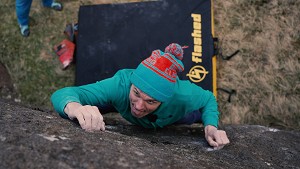

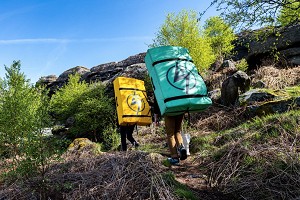




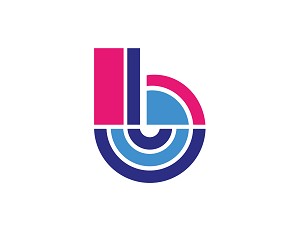

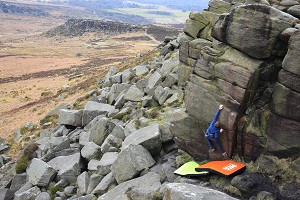
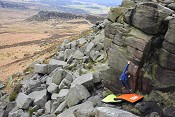
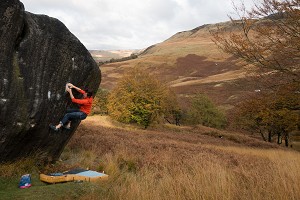
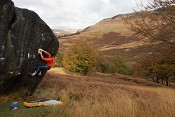
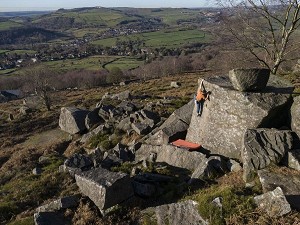
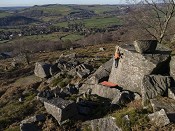
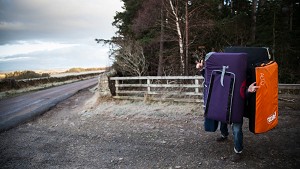




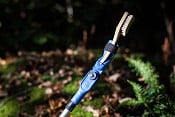
Comments
Have you tested it much on damp, sloped, grassy landings? If so, does it stay put when you land on it? It looks like the wipe clean outer could make it more prone to sliding down the hill.
Good question...
As a bit of a backstory I'll give a long/rambling answer, which may/may not be relevant.
Back when we were doing the Midsize Bouldering Mat Group Test a few years ago I remember using the Ocun Dominator on a day out at the Roaches. It was a cold day, with a hard frost in the shade, but where the sun had hit this had turned into wet mud. At the time we were trying Hard Arete/Tetris, which has an awkward/slopey landing. I remember someone taking a fall onto the Dominator and accelerating from 0-60 in around 0.5 seconds, careering down the slope towards the bushes below - it was terrifying to watch and potentially quite dangerous!
That said, the Dominator has a PVC bottom, which is quite different (and a lot smoother) than the base of the Guts, which is made from recycled polyester + TPU coating (and has a generally more grippy feel). The other thing working in the Guts favour is that the way you land on it, and the way the pad reacts, means that you tend not to slip around too much, further increasing its stability.
That said, clearly all pads slip on slopey ground, but I guess what I'm saying is that the Guts is as good as any, possibly better, and certainly no way near as bad as anything with a PVC base.
Hope that answers the question.
you are both clearly unfamiliar with the advanced techniques of securing pads with nests of warthogs, bulldogs, terriers and talons.
up your game ladies and gents ;)
Did these make it into my Bouldering ‘Essentials’ article? If not I should hang my head in shame...
Or your bag/shoes works just as well. Strange concern really, I've never used a pad in my entire life that doesn't effectively transport you down a grassy slope as 1 million mph